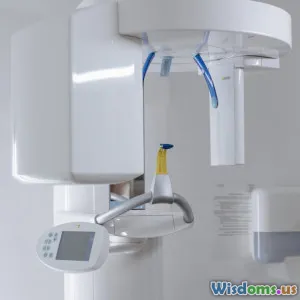
Top 7 Ways AI Is Transforming Healthcare Diagnostics This Year
8 min read Explore the top 7 ways AI revolutionizes healthcare diagnostics in 2024, enhancing accuracy, speed, and patient outcomes. (0 Reviews)
Top 7 Ways AI Is Transforming Healthcare Diagnostics This Year
Artificial Intelligence (AI) has emerged as a game changer in healthcare, especially in diagnostics where speed and accuracy can mean the difference between life and death. In 2024, AI technologies are not merely emerging trends—they are integrated allies in medical diagnosis, breaking new ground with tangible improvements in patient outcomes and healthcare efficiency. This article delves into the top seven ways AI is reshaping diagnostics today, backed by real-world applications and data-driven insights.
1. Enhanced Medical Imaging Interpretation
Medical imaging has been revolutionized by AI-powered algorithms capable of interpreting X-rays, MRIs, CT scans, and ultrasounds with remarkable precision. Unlike traditional methods, AI models analyze vast amounts of imaging data to identify patterns and subtle abnormalities that human eyes might overlook.
For example, Google's DeepMind has developed algorithms for retinal scans that detect eye conditions such as diabetic retinopathy with accuracy rivaling expert ophthalmologists. Similarly, Zebra Medical Vision offers AI radiology tools credited with improving early cancer detection rates by analyzing imaging three to four times faster than human analysts.
According to a study published in Nature Medicine (2022), AI-assisted imaging reduced diagnostic errors in detecting breast cancer by 5-10%, significantly impacting treatment initiation timelines.
2. Predictive Analytics for Early Disease Detection
AI-driven predictive models utilize patient data—ranging from genetic profiles to electronic health records—to forecast disease risk and progression. These insights enable clinicians to offer proactive care, catching illnesses before symptoms emerge.
IBM Watson Health’s oncology platform illustrates this well by analyzing data to predict cancer progression and suggest personalized interventions. Stanford researchers developed an AI algorithm predicting heart failure onset with 88% accuracy up to six months ahead of traditional diagnosis.
This predictive capacity is especially crucial in chronic diseases like diabetes and Alzheimer's, where early intervention can dramatically improve prognosis.
3. Accelerating Pathology with Digital Slide Analysis
Traditionally, pathologists manually examine tissue samples under microscopes, a painstaking and time-consuming process. AI-powered digital pathology automates this by scanning and analyzing slides for cancerous cells, tumor grading, and other indicators.
Paige.AI is notable for its FDA-approved AI tool that assists pathologists in identifying prostate and breast cancer more rapidly, with accuracy rates exceeding 90%. This technology not only speeds diagnoses but also helps standardize interpretations, reducing variability caused by human fatigue or experience level.
Hospitals integrating AI pathology report a 30-40% decrease in turnaround times, accelerating treatment decisions.
4. Personalized Diagnostic Pathways
AI facilitates personalized diagnostics by combining diverse data streams—imaging, genomics, patient history—to tailor assessments uniquely to each individual.
A 2023 survey in The Lancet highlighted AI's role in crafting diagnostic algorithms customized to ethnic backgrounds and genetic markers, mitigating bias and improving outcome equity. For instance, Tempus Labs uses AI to integrate genomic and clinical data for cancer diagnosis and therapy selection, resulting in treatments precisely targeted to tumor biology.
Personalized diagnostics empower clinicians to move beyond one-size-fits-all paradigms, offering patients the care that suits their biology and lifestyle.
5. AI-Driven Symptom Checkers and Voice Analysis
Connected health applications leverage AI-based symptom checkers and voice analysis tools that patients can use remotely. These technologies provide preliminary diagnostic guidance and alert clinicians to abnormalities for follow-up.
Babylon Health has developed an AI chatbot triangulating symptoms to suggest possible conditions with high sensitivity. Meanwhile, startup Beyond Verbal uses voice analysis to detect vocal biomarkers related to respiratory diseases or mental health disorders.
Such tools expand diagnostic reach beyond clinics, facilitating early medical engagement and continuous health monitoring.
6. Real-Time Monitoring with Wearable AI Devices
Wearables infused with AI algorithms continuously collect physiological data—heart rate, oxygen saturation, blood glucose—detecting anomalies at the earliest onset.
Apple Watch's AI-enhanced ECG feature identifies atrial fibrillation with substantial accuracy, alerting users and their doctors promptly. Similarly, Dexcom’s AI-enabled glucose monitors predict dangerous blood sugar dips, allowing preemptive management.
These real-time diagnostics shift healthcare from reactive visits to proactive, preventive models, improving chronic disease control and reducing emergency admissions.
7. Streamlining Diagnostic Workflow via Automation
Beyond interpretation, AI optimizes the entire diagnostic workflow. Automating tasks such as appointment scheduling for diagnostic tests, image capture standardization, and preliminary report generation frees clinicians to focus on nuanced decision-making.
Mayo Clinic’s implementation of AI-driven workflow software resulted in a 25% efficiency boost in radiology departments, enabling faster patient throughput without compromising diagnostic quality.
With AI managing administrative burdens, clinicians gain more bandwidth to deliver personalized care and engage in research and training.
Conclusion
This year, AI continues to transform healthcare diagnostics by enhancing speed, precision, and personalization. From radiology and pathology to predictive analytics and patient-centered tools, AI innovations are not distant possibilities but present realities revolutionizing patient care. As the technology matures and integrates deeper into healthcare systems, the potential for improved outcomes, reduced costs, and equitable access grows exponentially.
The fusion of AI and diagnostics is paving the pathway toward a future where diseases are detected earlier, treated more effectively, and managed more conveniently—empowering both patients and providers alike. Staying informed and embracing these advances will be crucial for healthcare professionals and stakeholders committed to the evolution of medicine.
References:
- Nature Medicine (2022). AI in Breast Cancer Detection: Outcomes Study.
- The Lancet (2023). Personalized Diagnostic Algorithms Across Populations.
- IBM Watson Health Oncology Platform Case Studies.
- Mayo Clinic AI Workflow Efficiency Report (2024).
Quote: “AI gives us a magnifying glass over patient data — revealing what was once invisible.” — Dr. Lisa Nielsen, AI in Medicine Expert
Embrace this transformative journey by exploring AI-powered diagnostic solutions, assessing their integration in your healthcare practice, and advocating for ethical, data-driven advancements in medicine.
Rate the Post
User Reviews
Popular Posts




















